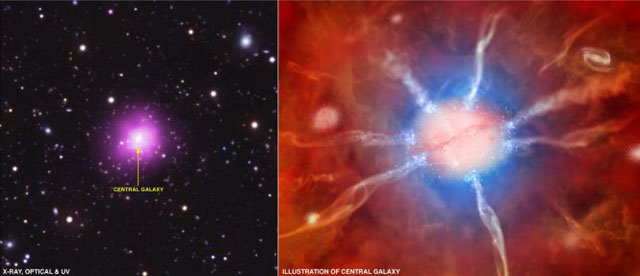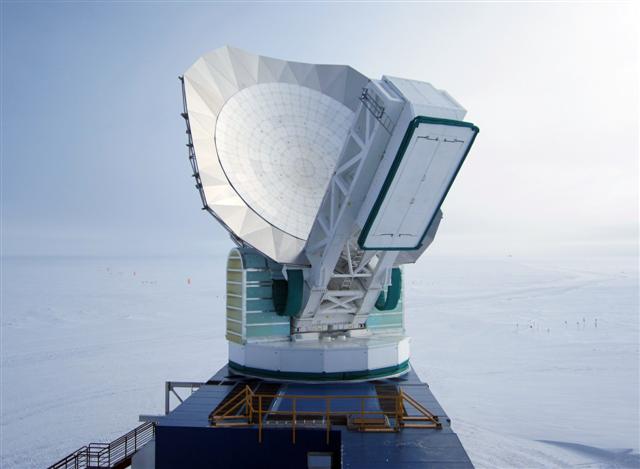|
Cluster of discoveriesSouth Pole Telescope finds fastest star-making region in the universePosted August 17, 2012
Astronomers have found an extraordinary galaxy cluster, one of the largest objects in the universe, breaking several important cosmic records. Observations of the Phoenix Cluster with the National Science Foundation’s South Pole Telescope (SPT) Stars are forming in the Phoenix Cluster at the highest rate ever observed for the middle of a galaxy cluster. The object also is the most powerful producer of X-rays of any known cluster and among the most massive. The data also suggest the rate of hot gas cooling in the central regions of the cluster is the largest ever observed. From the source
Officially known as SPT-CLJ2344-4243, the cluster has been dubbed the “Phoenix Cluster” because it is located in the constellation of the Phoenix and because of its remarkable properties. The Phoenix Cluster is located about 5.7 billion light years from Earth. Scientists taking part in the SPT collaboration found the cluster using the Sunyaev-Zel’dovich (SZ) effect Galaxy clusters, which are among the largest objects in the universe, contain enough hot gas to create detectable “shadows” in the light left over from the Big Bang “The mythology of the Phoenix — a bird rising from the dead — is a perfect way to describe this revived object,” said Michael McDonald SPT is a radio telescope, which sports a 10-meter wide dish, located at the Amundsen-Scott South Pole Station Observations made by the Chandra X-ray Observatory in space and by the NSF-managed Gemini Observatory 
Photo Credit: Sven Lidstrom/Antarctic Photo Library
The South Pole Telescope bathed in auroral light.
This light has travelled for 14 billion years across the entire observable universe to get to Earth. If it passes through a massive cluster on its way, then a tiny fraction of the light gets scattered to higher energies. This is the SZ effect. Predicted in 1972, the SZ effect was first demonstrated to detect previously unknown clusters of galaxies by the SPT collaboration in 2009. Observations of the effect have since opened a new window for astronomers to discover the most massive, distant clusters in the universe. “The beauty of the SZ effect for cosmology is that it is as easy to detect a cluster of galaxies in the distant reaches of the observable universe as it is for one nearby,” said John Carlstrom Like other galaxy clusters, Phoenix contains a vast reservoir of hot gas, containing more normal matter than all of the galaxies in the cluster combined. The emission from this reservoir can only be detected with X-ray telescopes like the Chandra X-ray Observatory. The prevailing wisdom had once been that this hot gas should cool over time and sink to the center of the cluster, forming huge numbers of stars. However, central galaxies in the cluster have formed very few stars over the last few billion years. Astronomers think that the super-massive black hole in the central galaxy of a cluster pumps energy into the system, preventing cooling of gas from causing a burst of star formation. The famous Perseus Cluster is an example of a black hole bellowing out energy and preventing the gas from cooling to form stars at a high rate. 
Photo Credit: NASA
Left, a composite image of the Phoenix Cluster from different observatories. Right, an artist's conception of the galaxy cluster.
With the black hole not producing powerful enough jets to halt cooling, the center of the Phoenix Cluster is buzzing with stars that are forming 20 times faster than in the Perseus Cluster. This rate is the highest seen in the center of a galaxy cluster and is comparable to the highest seen anywhere in the universe. The frenetic pace of star birth and cooling of gas in Phoenix are causing both the galaxy and the black hole to add mass very quickly — an important phase that the researchers predict will be relatively short-lived. “The galaxy and its black hole are undergoing unsustainable growth,” said co-author Bradford Benson Remarkably, the Phoenix Cluster and its central galaxy and super-massive black hole are already among the most massive known objects of their type. Because of their tremendous size, galaxy clusters are crucial objects for studying cosmology and galaxy evolution, so finding one with such extreme properties as the Phoenix Cluster is significant. The SPT collaboration has now completed a SZ survey of the 2500 square degrees of the southern sky that began in February 2007. It has found approximately 500 “SZ effect” galaxy clusters and published more than 20 papers in peer-reviewed journals. Further analysis of the collected data could reveal the existence of additional galaxy clusters. NSF-funded research in this article: John Carlstrom, John Ruhl, Joseph Mohr, William Holzapfel and Nils Halverson, University of Chicago, Award No. 0638937 |



For USAP Participants |
For The Public |
For Researchers and EducatorsContact UsNational Science FoundationOffice of Polar Programs Geosciences Directorate 2415 Eisenhower Avenue, Suite W7100 Alexandria, VA 22314 Sign up for the NSF Office of Polar Programs newsletter and events. Feedback Form |


